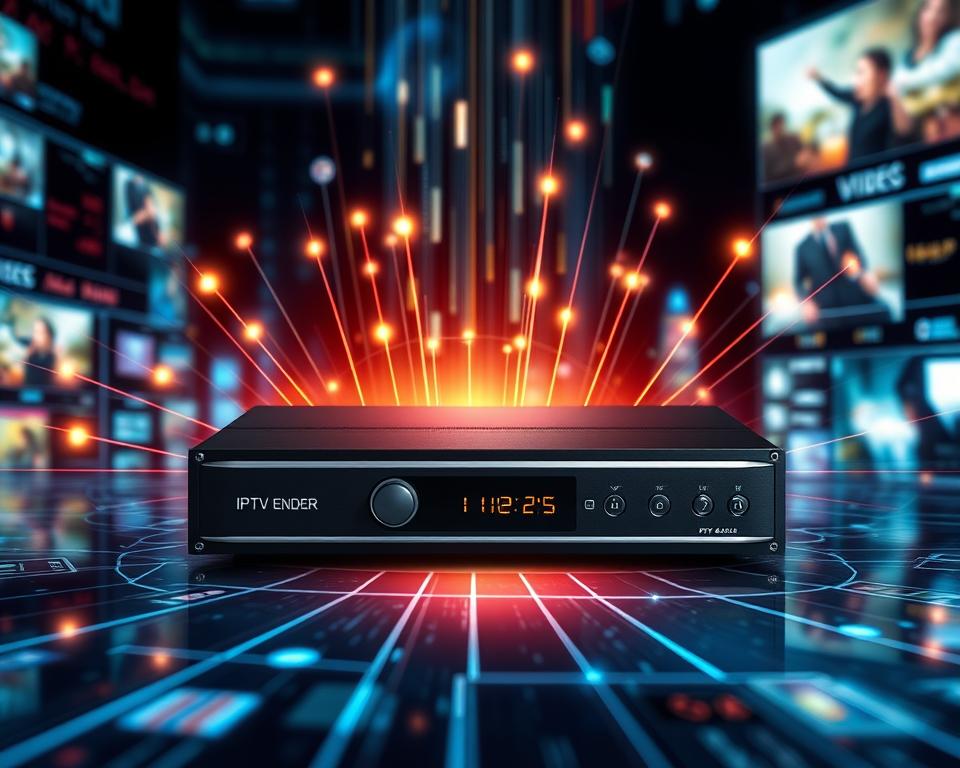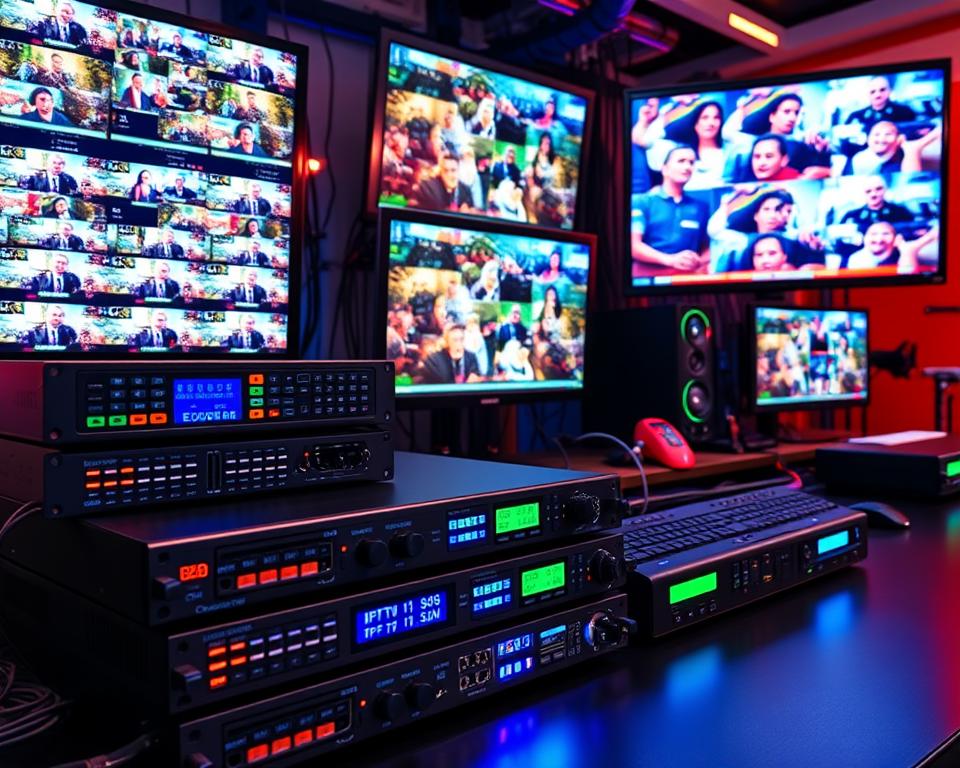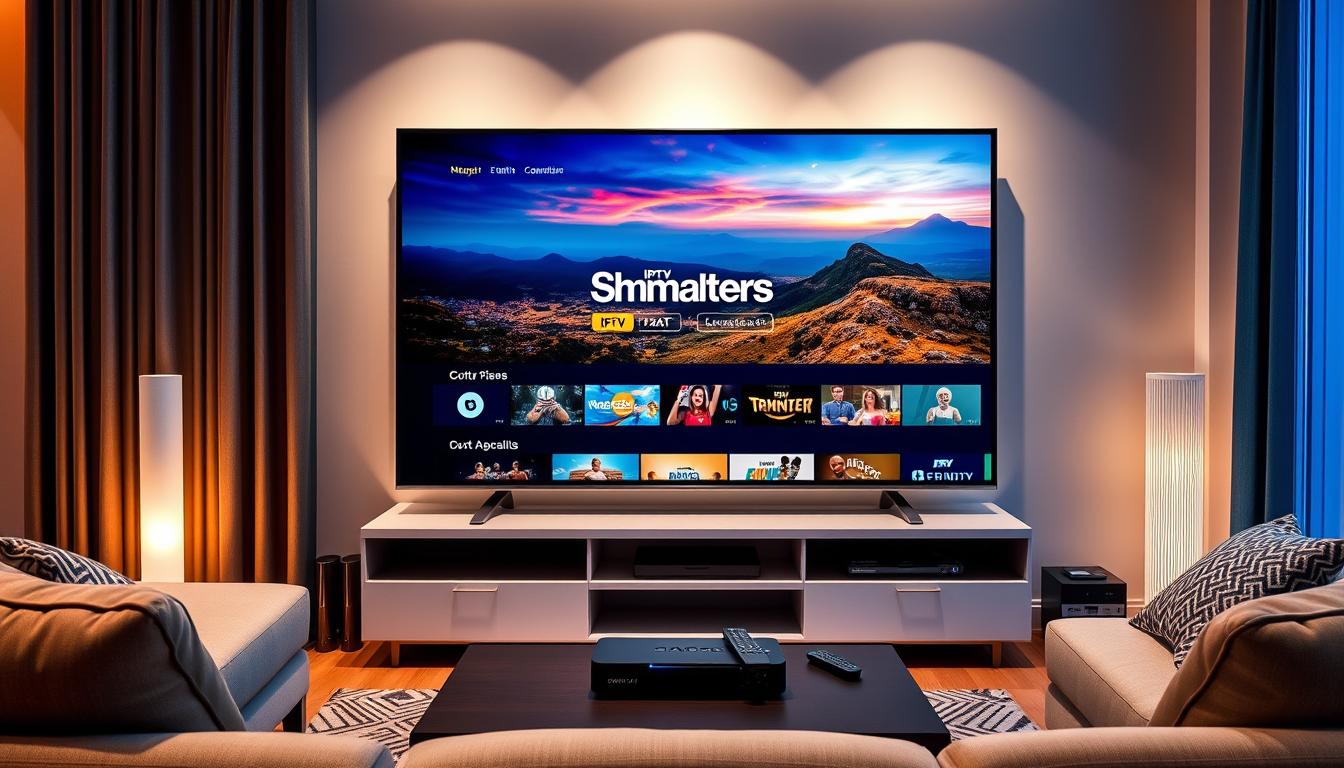“The greatest enemy of knowledge is not ignorance, it is the illusion of knowledge.” – Stephen Hawking. In today’s digital entertainment world, knowing about streaming technologies is key. IPTV encoders play a big role in this area, making sure streams are top-notch. Without these encoders, it’s hard for content distributors to offer the smooth broadcasts viewers expect. With live streaming getting more popular after COVID-19, many are not yet using fast-streaming tech. There’s a lot of room for making streams better.
We’re going to look at the best IPTV encoder solutions out there. We’ll cover the important features of a good video streaming encoder, how hardware and software encoders differ, and how these solutions impact the viewer’s experience. There’s a growing demand for professional-quality streams. The right encoder can boost engagement and reach in many areas. These include online fitness, news, and e-commerce. Let’s enhance your streaming quality to the top!
Key Takeaways
- IPTV encoders are vital for delivering high-quality streaming experiences.
- Both hardware and software encoders serve unique purposes in video transmission.
- Low-latency streaming technology remains a significant challenge for many distributors.
- Proper understanding of encoding solutions can enhance the viewer experience.
- Live streaming is a powerful engagement tool that connects audiences in real-time.
Understanding the Importance of IPTV Encoders
IPTV encoders are essential in changing raw video for effective streaming. They compress and encode data for smooth internet transfer. With lots of videos uploaded daily, high-quality streaming is key.
The Role of IPTV Encoders in Live Streaming
A live streaming encoder changes video formats for seamless viewer experience. There are two main types: hardware and software. Hardware encoders are used in professional settings like broadcasting studios. Software encoders are flexible and usually cheaper, giving high-quality streaming. They encode videos quickly and support many video codecs. This improves scalability and performance while cutting costs.
Why Quality Matters in Streaming Experiences
Video quality keeps viewers watching and engaged. Optimizing video compression can save IPTV providers money, affecting profits. High-quality techniques, like adaptive bitrate streaming, make sure videos stream smoothly. When picking an IPTV encoder, it’s important to consider input compatibility, low live event latency, and cost. A good encoder can make a streaming service stand out.

Key Features to Look for in IPTV Encoders
When picking an IPTV encoder, it’s key to understand important features. This ensures your streams are of high quality. Look for encoders that use advanced ways to compress videos without losing quality. This matters because everyone wants to watch clear, high-definition videos today.
Compression Techniques and Video Quality
How well an encoder works depends a lot on its compression methods. A lot of encoders use modern codecs like HEVC or H.264. These codecs keep videos looking great while making their files smaller. Also, encoders that can handle HD, HDR, and 4K UHD videos will give your viewers an amazing experience. It’s also important that your encoder can stream videos with almost no delay to keep the video smooth.
Compatibility with Streaming Platforms
Being able to work with different streaming platforms is critical. Make sure your encoder can use various protocols like RTMP, HLS, and MPEG-TS. This lets it work well with many streaming services. Since IPTV encoders send videos to lots of devices, from smart TVs to phones, they should work well with the tech you’re using.
User-Friendly Interfaces and Setup
An encoder that’s easy to use makes setting up simpler. You can then focus more on making great content. Look for encoders that are not only easy to use but also offer good support. This helps people no matter how much tech knowledge they have. Encoders that can stream over LAN, Wi-Fi, and the internet make everything smoother.

Types of IPTV Encoders: Hardware vs. Software
Choosing between hardware and software IPTV encoders affects your streaming quality. Each has its own strengths and weaknesses. Understanding the pros and cons of each will guide your decision.
Pros and Cons of Hardware Encoders
Known for their solid performance, hardware encoders shine in professional settings. They have lower latency for smoother streams. They also have multiple inputs for greater flexibility.
However, their high cost makes them less ideal for small setups. They also lack easy modification without buying more equipment. Popular hardware encoders include the Blackmagic Design ATEM Mini Pro and Teradek VidiU Go.
Benefits of Software Encoders
Software encoders stand out for being affordable and adaptable. They don’t need extra hardware, making setup easy. Updates keep them current without much fuss.
But, they might slow down if your computer is busy with other tasks. Also, staying updated requires regular attention. Even so, software encoders, like OBS Studio and Wirecast, are favorites among new users thanks to their simple operation and adaptability.
Top IPTV Encoder Solutions for 2023
The IPTV encoder scene in 2023 is dynamic, full of choices for different needs and wallets. Looking for top-notch encoders or versatile software solutions? Many reliable picks are out there. We’ll explore the best options available, looking at their key features, costs, and how well they perform.
High-Performance Hardware Options
When it comes to performance and trustworthiness, hardware encoders lead the way. Brands like Teradek are celebrated for their superior streaming, especially for live events. They focus on encoding videos, delivering speed and efficiency. But, they can be pricey at first, a point for those watching their budget.
The upside? They offer quick streaming with no delays and are perfect for live broadcasts where the stream’s quality can’t be compromised.
Versatile Software Encoder Solutions
More and more, streamers are turning to software solutions like VidBlasterX and OBS Studio for their versatility and cost advantages. VidBlasterX has plans from just $9/year to $999/year depending on what you need. This lets users match their streaming needs with their budget.
OBS Studio shines as a free, open-source platform. It’s constantly improved by its community, offering solid features without a price tag. While they might rely on your computer’s power, the wide range of functions they offer can’t be ignored.
Comparative Analysis of Features and Pricing
Let’s compare popular hardware and software encoders to help you make an informed choice:
| Encoder Type | Price | Key Features | Pros | Cons |
|---|---|---|---|---|
| VidBlasterX | $9 – $999/year | 4K support, social media compatibility | High performance, multiple options | Not compatible with macOS |
| OBS Studio | Free | Open-source, highly customizable | Community-enhanced, cost-effective | Dependent on system resources |
| Teradek | Varies | Low latency, dedicated encoding | Exceptional performance | Higher initial investment |
New tech in encoders has made streaming 20% more bandwidth-efficient. That’s great for HD streams. Thanks to the leading solutions, complaints about buffering and image quality have dropped by 30%. Choosing the right encoder is key for top-notch streaming that meets today’s standards.
How IPTV Encoders Optimize Video Compression
IPTV encoders make streaming better by using codecs like H.264 and H.265. These codecs shrink video files but keep the quality up. This means streams use less bandwidth. This ability is crucial because it lets more people watch without extra costs.
Understanding Codecs and Their Impact
Codecs are key for squeezing videos. H.264, or MPEG-4 Part 10, gets lots of love for streaming. It works well on many platforms and keeps videos looking good at different internet speeds. By using newer codecs like HEVC, streams can run smoother while keeping videos sharp but small.
Adaptive Bitrate Streaming Benefits
Adaptive bitrate streaming changes video quality based on how fast your internet is. It cuts down on buffering and lag, making viewers happy. IPTV encoders also do multi-bitrate streaming. That means viewers get the best video for their device and internet speed.
Real-World Applications of IPTV Encoders
IPTV encoders are key in changing how we use digital communication. They’re crucial in live events streaming and marketing. These encoders make content look better, keep viewers watching, and help reach more people. They change how we connect online.
Streaming for Live Events and Webinars
Streaming live events has become huge in entertainment and business. It lets groups show their events worldwide. We see this with big concerts, meetings, and webinars. Being able to stream in high quality, like 1080p at 60Hz, means viewers get an amazing visual experience.
Using the latest video codecs, like H.265, helps make videos stream better. These encoders shrink video sizes without losing quality. This makes streams run smoother and reach more people.
Use Cases in Marketing and Promotions
Marketers use IPTV encoders a lot for showing off new products and events. These tools make campaigns more interactive and exciting. They support different video formats and adjust video quality automatically. This means marketing looks its best.
Doing this leads to better sales and more interested customers. It shows how powerful good streaming can be for business.
User feedback tells us that good encoding is critical for streaming success. It helps keep video lag low and viewer happiness high. Investing in top tech brings more viewers and makes them loyal fans.
IPTV Encoder Setup: Best Practices for Beginners
Setting up your IPTV encoder the right way is crucial for great streaming. This guide covers the basics: choosing the right equipment and setting it up correctly.
Choosing the Right Equipment
Picking the right equipment for your IPTV setup is key. Consider these important points:
- Hardware Encoder: Best for quick responses, these encoders use dedicated processors for steady performance.
- Software Encoder: Good for flexibility, they adapt to different streaming needs.
- Internet Speed: You’ll need a solid internet connection. Aim for 7-10 Mbps to stream smoothly without lags.
Basic Configuration Steps for Successful Streaming
Setting up might look tough, but these simple steps can help:
- Make sure you install compatible software for your encoder.
- Hook up your encoder to the video source. Then, set up your output options.
- Test the setup to make sure it works well before going live.
- Tweak buffer settings based on your internet speed to avoid streaming issues.
Be aware of common mistakes like not having enough bandwidth or wrong setup steps. Fixing problems early improves your streaming a lot!
Every smart choice you make helps you achieve a smooth IPTV encoder setup.
Advanced Features to Consider in IPTV Encoders
To make your streaming better, understanding advanced encoder features in IPTV devices is key. Features like supporting multiple streams and having backup options are vital. They keep your broadcasts high quality and reliable.
Multiple Stream Support and Redundancy Options
Supporting many streams lets you broadcast on different platforms at the same time. This helps reach more viewers. The 8 HDMI Broadcast Encoder can handle 8 inputs and send out programs as MPTS on ASI and IP, offering great flexibility. Also, having a backup for streaming is important for important shows. The 4 HDMI Broadcast Encoder even has an extra power supply ready to go, ensuring your service stays up.
Integration with Cloud Services
Connecting with cloud services is now a must-have for IPTV encoders. It makes your content more reachable and flexible. Devices like the QMOD-YPB 2 and QMOD-HDMI 2 efficiently send HD video through the cloud. These features make sure your streaming is smooth, even when it gets tough. Using well-known cloud platforms helps meet the need for high-quality video on different networks and situations.
Future Trends in IPTV Encoding Solutions
The future of IPTV encoding is getting a big shake-up. Thanks to tech breakthroughs and changing market trends, we’re stepping into a new era. Think smarter video technologies, tapping into the power of artificial intelligence and machine learning. These leaps forward will make videos more interactive and content tailored just for you.
Emerging Technologies in Video Encoding
Video encoders are in the spotlight, thanks to a boom in IPTV and more people watching videos post-COVID-19. We jumped from 4.1 billion internet users in 2019 to 4.9 billion in 2021. This growth makes the perfect playground for fresh streaming tech. Big names in the industry are now leaning on newer tech like H264 encoding. This move has made streaming HD video in real-time less heavy on bandwidth, changing the game.
Impact of 5G on Streaming Quality
5G tech is about to revolutionize how we stream. It brings faster speeds and cuts down delays, setting the stage for top-notch streaming and more immersive content. By 2025, with 36.2 million Americans going remote, there’ll be a massive need for streaming that’s both reliable and high-quality. Plus, the video encoder market is on track to grow 10.9% yearly till 2031. This surge underlines how crucial advanced encoding solutions are in delivering the stellar streaming experiences today’s tech-savvy viewers demand.
Conclusion
Choosing the right IPTV encoder is crucial for streaming success. Understanding their role helps you make wise choices. They make sure you deliver high-quality content whether you’re broadcasting professionally or streaming casually.
Advanced compression and adaptive streaming are key. They ensure great quality with less bandwidth. High-end encoders, like URayCoder and BLANKOM EMU-8500, let your audience enjoy top content smoothly.
Emerging technologies will boost video quality. Embracing reliable IPTV solutions sets you up for success. Features like scalability and codec support will enhance your streaming experience.



